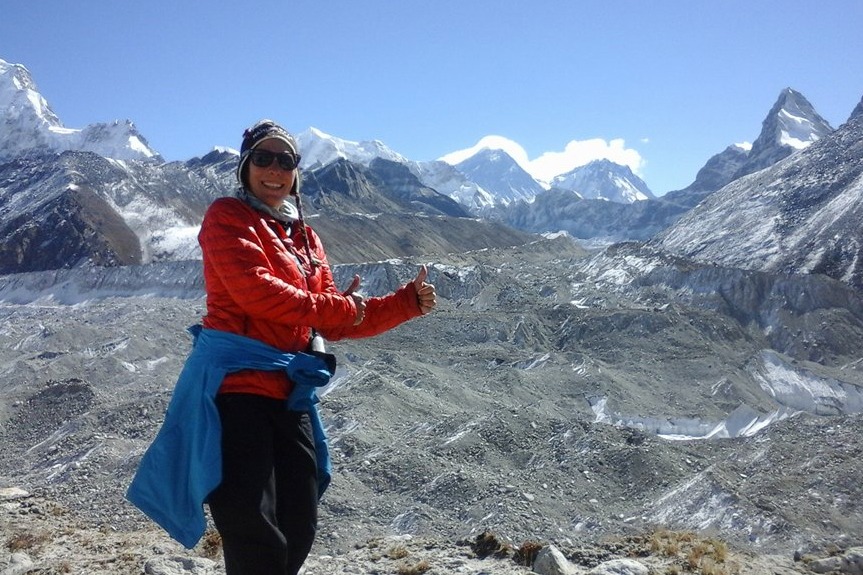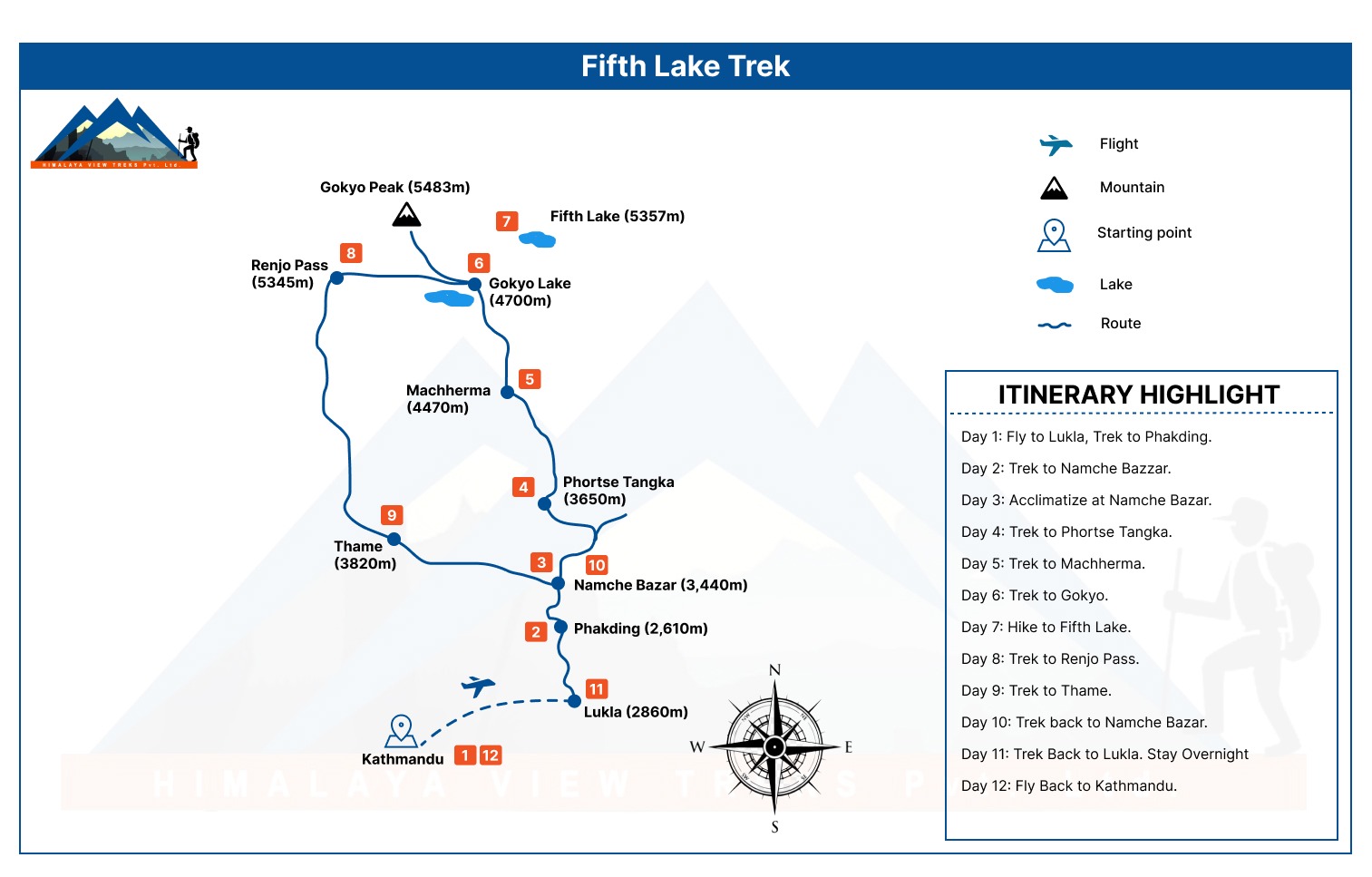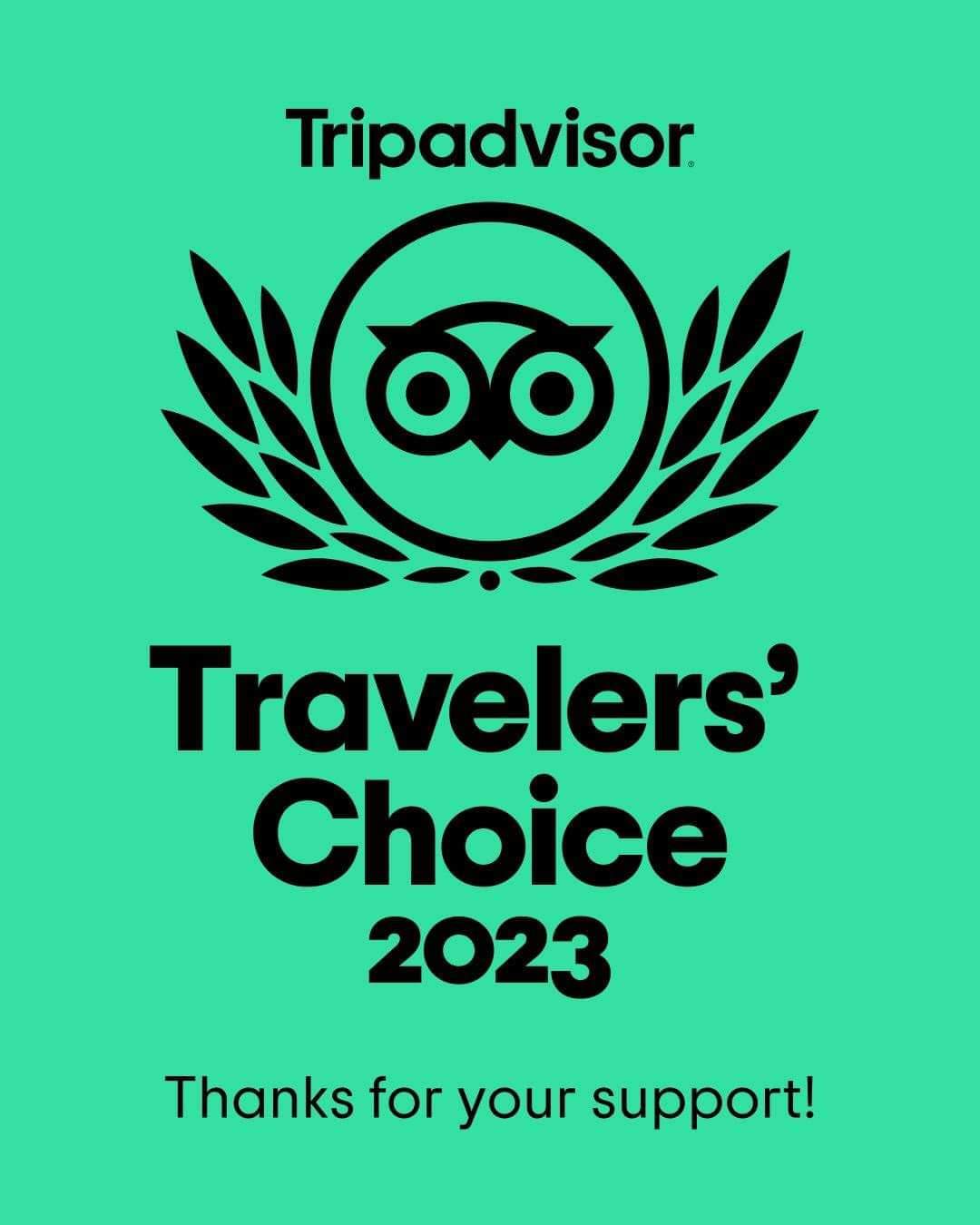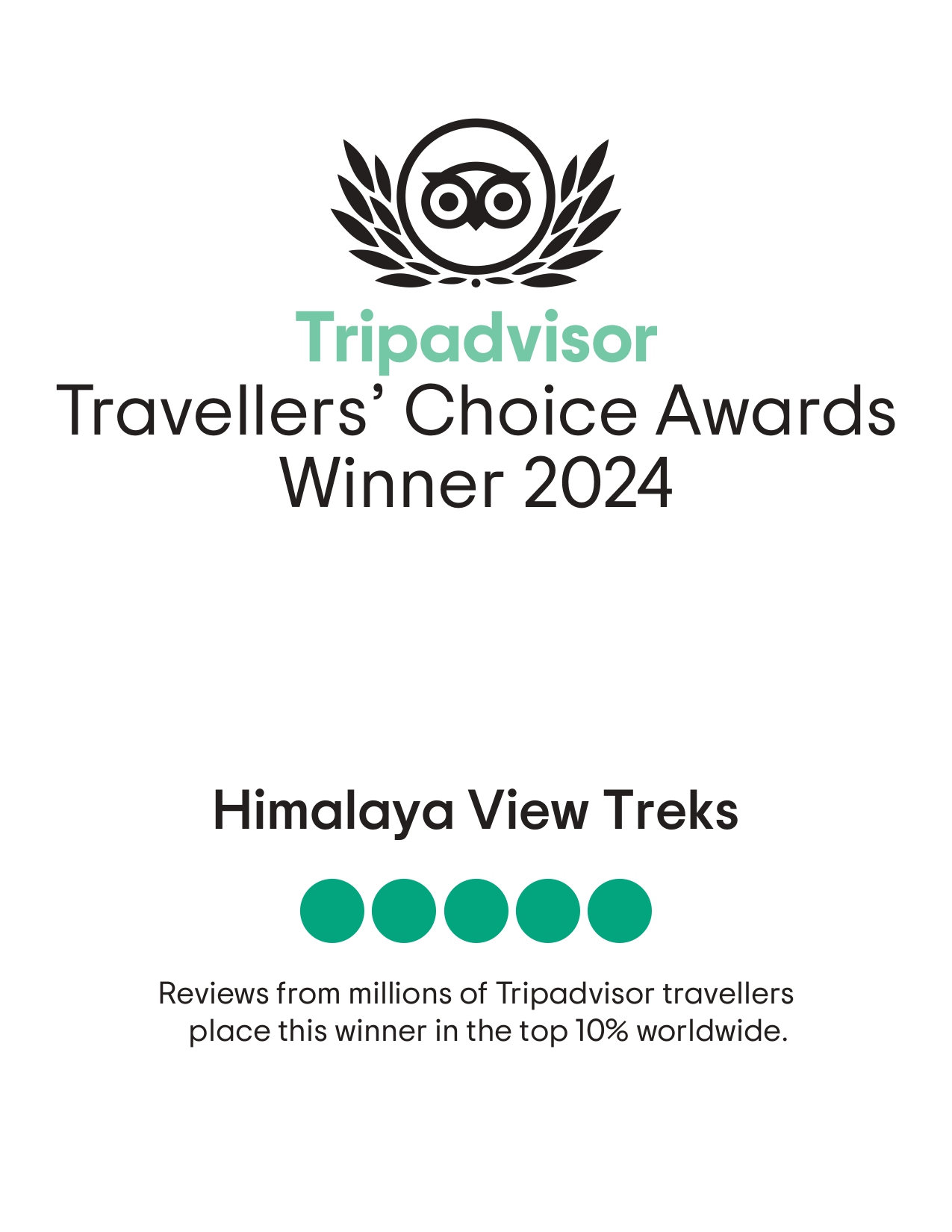- Details
- Short Itinerary
Detailed itinerary
Itinerary- Tour Includes/Excludes
- Useful Info
- Map
- FAQ
Trip overview
HVT is organizing the 5357m Fifth Lake Trek since we found a better view of Mt. Everest and all other snow-capped high Himalayas of the Everest Region. The fifth lake is located just a front of mount Cho Oyu Base camp.
5357m Fifth Lake is the name of the number 5 Lake in Gokyo valley and it takes just 3 hours to day hike from Gokyo.
After you reached the 5th Lake you will be able to see unforgettable mountains view including Mt. Everest, Mt Cho Oyu, Mt. Makalu, Nuptse, Lhotse, and many more. We suggest to our valuable clients who heading to Gokyo valley Trek not to miss the fifth Lake. The fifth Lake provides a better view than Gokyo Ri. Trek to 5th Lake is just 7 hours from Gokyo to Gokyo including break and the altitude is less than Gokyo Ri, just (5000M)
During this trip, you can explore the hidden natural and cultural beauty of the Khumbu region. Fifth Lake Via Gokyo Valley provides fantastic views of well-known 7,000m to 8848m peaks and a region with very few western trekkers. We have the superb classic objectives of ascending the summits of Fifth Lake ridge for unrivaled Panorama views of Mount Everest, Cho Oyu, Makalu, Lhotse, and many more Himalayan giants. Everest Gokyo valley Fifth Lake is an ultimate high-altitude trek, in the world’s most spectacular mountain land. Think of Everest Region not just as a trek but more as one of the premium mountain journeys you are ever likely to undertake in your lifetime.
Himalaya View Treks offers an adventurous and romantic Gokyo 5th Lake Trek in Nepal.
Himalaya View Treks designed the fifth Lake Gokyo Trek itinerary by including all the popular places in the areas with minimum required days. If you want more days trek in the surrounding areas of Mount Everest Region then we will redesign its itinerary as per your request. During Gokyo Lake Trek, Himalaya View Treks provides experienced leadership-trained Trekking guides, better accommodations, healthy foods, and strong porters with full insurance covered.
Short Itinerary
FIFTH LAKE TREK - 12 DAYS ITINERARY
Day 01: Kathmandu to Lukla (2800m), and trek to Phakding Stay overnight at lodge.
Day 02: Phakding to Namche Bazaar (3440m.). Stay overnight at lodge.
Day 03: Acclimatization at Namche Bazaar, Stay overnight at lodge.
Day 04: Trek to Phortse Tangka (3810m ). Stay overnight at the lodge.
Day 05: Phortse Tangka to Machherma (4470m). Stay overnight at the lodge.
Day 06: Macharmo to Gokyo (4790m). Stay overnight at the lodge.
Day 07: Hike to Fifth Lake (5357.) and Stay overnight at the lodge.
Day 08: Gokyo – Renjo Pass (5345m) – Rermo Pokhari (4875m). Stay overnight at the lodge.
Day 09: Rermo to Thame (3800m). Stay overnight at the lodge.
Day 10: Thame to Namche. Stay overnight at the lodge.
Day 11: Namche to Lukla. Stay overnight at the lodge.
Day 12: Fly back to Kathmandu by flight (35 minutes flight)
Detailed Itinerary
Day 01: Kathmandu to Lukla flight and then trek to Phakding
Early in the morning fly to Hillary airport Lukla (2,860m) about 35 minutes. Trek to Phakding (2,652m) 3/4 hours walking distance. Stay overnight at tea house. The trail follows the bank of the Dudhkoshi River.
Day 02: Trek to Namche bazzar
Trek from Phakding to Namche Bazar (3,440m) 6/7 Hours. Stay overnight at tea house, Namche Bazar is capital market of Khumbu valley.
Day 03: Acclimatization day at Namche Bazzar
Acclimatization day, Hike to Everest view hotel (3,880m) and Khumjung village, including Hillary school and hospital, you can able to see Mt. Everest and surrounding mountains if good weather. Hike back to Namche and overnight at same hotel in Namche.
Day 04: Trek to Dole
Trek from Namche to Dole (4,200m) Hike through the lovely Sherpa Village of Khumjung, admiring incredible views of Mt. Thamserku, and Ama Dablam, Trek lead with slightly uphill from Namche. Through Rhododendron forest, you can able to see wildlife like musk deer, Himalayan Thar and Danphe etc. Walking distance 5/6 hours, stay overnight at tea house.
Day 05: Trek to Machhermo
Trek from Dole to Machchhermo (4470m). Beautiful scenic trail is a steep climb taking you through scrub juniper. Leaving Dole there is an uphill gradient for around half an hour then a gentler uphill the rest of the way. The Dudh Koshi River lies far below. Hiking on towards the tiny teahouse settlement of Machhermo the trail comes to a ridge above the village with stunning views of Kusum Kangaroo and Thamserku. Walking distance 6/7 house stay overnight at Tea house
Day 06: Trek to Gokyo Lake
Gokyo lake is the final destination of the Trip. Gokyo lake is the 3rd lake situated at Gokyo. (4,750m) walking distance 5/6 hours, stay overnight at tea house.
Day 07: Hike to Fifth Lake
After breakfast, prepare pack lunch and hike to Fifth Lake. ( 5200m) Fifth lake is situated at base camp of Choyo and Mt Everest as well surrounding peaks views from Fifth Lake are better than Gokyo Ri and kalpathar. Walking distance 6/7 hours, stay overnight at same tea house at Gokyo.
Day 08: Renjo La Pass to Lungden ( Lumde ) from Gokyo
Trek to Lumde Via Renjola pass (5360m),Bbest view of Everest regions himalayas., including Mt Everest, Makalu, and Rolwaling range. walking distance 6/7 hours, stay overnight at Tea house.
Day 09: Trek to Thame from Lungden
After breakfast, trek down to Thame, (3820m ) walking distance 5/6 hours. stay overnight at tea house.
Day 10: Trek to Namche from Thame
Trek back to Namche Bazar Altitude of Namche (3440m) On our trek along and among the magnificent mountains, we are trekking down towards Namche overnight at our teahouse lodge. Refresh and dinner- Thame to Namche Walking Distance 9.7 km (2-3 hours) 3440m/11285ft
Day 11: Trek to Lukla from Namche
Trek back to Lukla Altitude of Lukla (2840m) Walking distance 5/6 ) We trek all the way back to Lukla today to finish the trekking journey. We trek past Monjo and Phakding villages; encounter the Dudh Koshi River along the trail and eventually reach Lukla. As the final day of the trek, we can celebrate the beautiful adventure. We see off our trekking potters here today thanking them for all the help they provided to make our trip possible, overnight at our teahouse lodge refresh and dinner- Namche to Lukla Walking Distance 13km (5-6 hours) 2,800 m 9,100 ft
Day 12: Fly back to Kathmandu from Lukla
Fly to Kathmandu from Lukla in the morning Altitude of Kathmandu ( 1300m) (35 minutes). We wake up early for our flight back to Kathmandu. We say goodbye to the serene and magnificent mountains and board the flight to come back to the city civilization. The rest of the afternoon in Kathmandu will be at leisure. Walking around the streets of Kathmandu; souvenir shopping; finding a massage or relaxing at the hotel can be easy ways to spend time.
Included
- Airport pickup and drop as per client’s arrival and departure date
- Hotel- domestic airport- hotel by car/ van, depend on group sizes
- Domestic flights (Kathmandu - Lukla - Kathmandu) tickets including airport taxes
- All meals (Breakfast, lunch, and dinner) during your Gokyo Fifth Lake Trek
- 11 nights Hotel Accommodation during Gokyo Fifth Lake Trek
- Government licensed holder, fluent English Speaking, Familiar HVT guide
- One assistant guide if Group sizes is more than 10 trekkers)
- Strong local Porters for Carry trekker’s luggage One porter every 2 trekkers
- Guide and porter wages including their meals, accommodation, and Salary
- Staff insurance including medication coverage
- Guide and Assistance both ways Lukla flight Ticket
- Equipment for the Company staff
- Water purification drop or tablets for safe drinking water
- Sagarmatha National Park entry permit fee
- Khumbu Pashang Lhamu Rural Municipality permits fees
- Seasonal fresh fruits every day during your Gokyo Fifth Lake trek
- Oximeter to measure Pulse and oxygen level
- Company T-shirt as a Souvenirs, and duffle bag if needed
- Local government, taxes, including official Service Charge
- Trip completion Certificate
Not Included
- Hotel accommodation and meals In Kathmandu
- Personal expense (shopping, snacks, boil bottle water, hot (tea, coffee) and cold drinks, hot shower, alcohol, Wi-Fi, telephone call, battery charge fee during the Fifth lake Trek)
- Personal clothing and trekking gear
- Personal travel insurance including evacuation coverage (compulsory) up to 6000m)
- Additional costs if delays flights and outside the itinerary
- All the costs and expenses which are not mentioned in includes list
- Tips for guide and porters. in end of the treks
Useful Info
Fifth Lake trek Key Highlights:
- Complete five fabulous peaks all over 5,000 metres: the Fifth Lakle and the summits of Gokyo Ri.
- Trek in the more virgin valleys of the Khumbu while approaching the Fifth Lake and Choyu Base Camp.
- View Everest, Makalu, Lhotse and Cholatse, the Himalayan giants, in their astonishing glory.
- It’s a great opportunity to ascend Fifth Lake and relish grandstand views of Gokyo lake, Gokyo valley, and surrounding mountains.
General Information vital to this trek:
Best Season for this trip:
Doing this trek/climb at the right time is very important to the success of a trip of this kind. Spring (March-May) and autumn (October-November) are really the best seasons to do this trek. The monsoon season (June - early September) has less predictable weather, but some trekkers still choose this time as it aligns better with their vacation schedule. Winter season (December - February) gets pretty cold, and snow may block the passes, but often offers clear skies. Nonetheless, we suggest our guests make bookings for this venture in the spring or autumn, especially in the autumn of September/October. The weather is at its best for this high altitude trip. The views are crystal clear with sparkling blue skies & the finest weather you could ever imagine.
Difficulty on this odyssey
The Fifth Lake trek is rated “Challenging”. It is a very arduous adventure. This venture is more challenging than its sibling treks Everest Base Camp and Gokyo Lakes, but not as much challenging as trekking peaks such as Island Peak and Mera Peak. Nevertheless, doing this trip requires real good physical fitness & previous experience of trekking above 4500m.
Accommodation & Meals
The Everest Region has admirable infrastructure for trekkers. The teahouses (lodges) are of relatively high quality and they serve good meals, especially in Namche Bazar which you’ll pass on the way up and down.
Will I need travel insurance?
It’s mandatory and highly recommended to get travel insurance before embarking on any adventurous trips in Nepal.
We advise all our clients to get travel insurance that covers up emergency helicopter evacuation that may be needed in case of the occurrence of AMS (Acute Mountain Sickness) or any other reasons in high altitudes where there are no other means of transportation available. It is advisable to review carefully the insurance and its coverage before making the final decision. Carry proof of your insurance with you on the holiday and leave a copy next to your kin. You must ensure that your insurance provides an adequate level of protection and covers you well for the activities involved.
Equipment for Nepal Trekking
This section is intended to provide information on clothing and equipment requirements for Nepal Trek. It is not intended to be a final and authoritative checklist. For those who would like a more detailed discussion of these issues, we ask you to contact us at singbir@yahoo.com or via WhatsApp at +9779841146306
The following is a list of clothing and accessories that we recommend that you take with you. This is not intended to be a comprehensive clothing and equipment list, rather it is intended to act as a reminder of those items that we feel are essential for your comfort and convenience. However, we recommend that you may have your own personal preferences for clothing which may be equally as suitable.
Footwear: Equipment for Nepal Trek
1. Walking boots with suitable ankle support that have been worn-in prior to the trek, and which are waterproof
2. Trainer or casual shoes, for trekking and/or for traveling
3. Warm socks for colder areas
4. Gaiters, in case of rain or snow
Legwear
1. Loose, casual trousers for trekking
2. Thermal leggings for colder areas
3. Long skirt for women as an alternative to trousers
4. Waterproof trousers
Body
1. Selection of T-shirts, and long sleeved shirts, preferably not cotton
2. Thermal shirt for colder areas
3. Warm shirt, possibly fleece, for colder areas
4. Fleece jacket or warm wool jumper
5. Windproof, waterproof outer shell garment for higher altitudes
6. Down jacket (optional for cold nights & mornings; can be hired in Kathmandu cheaply)
Head / Hands
1. Wool or fleece hat, or balaclava
2. Hat or cap for sun protection while trekking
3. Sunglasses or goggles
4. Warm gloves
Other Items
1. Strong rucksack or large hold all to be carried by porters
2. Day sack to be carried personally
3. Plastic bags or stuff sacks to store/separate trekking gear inside your main bag
4. One-liter water bottle
5. Personal first aid kit to include essential items
6. Sleeping bag, 4 season
7. Torch, ideally head torch
8. Camera and film! – For those not to be forgotten shots of the Himalayas
9. Toilet items and towel
10. Large handkerchief/bandana for neck
Optional Items
1. Binoculars
2. Books (see Recommended Reading)
3. Altimeter
4. Compass
5. Playing cards/backgammon/chess set
Recommended Mountaineering Kit
In addition to the items mentioned above for trekking, the following is a list of the additional specialist items which are required for the trekking peaks.
Plastic or leather mountaineering boots, with gaiters & crampons that have been tested for a good fit.
Packing list for Peak Climbing In Nepal
1. Fleece trousers
2. Additional mitts and gloves suitable for climbing
3. Ice axe, and ski poles (note – ice axe can be hired in Kathmandu)
4. Climbing harness
5. 2 x tape slings
6. 2 x screw gate karabiners
7. Descended/abseil device
8. Ascender
And Finally
The most important things that you must take with you are a sense of humor, an open mind, and an understanding that a trip to Nepal is an adventure to a land that is very different from your own.
Nepal trekking permit and National Parks entrance Fee:
National Park Fee will be required to trek in common areas such as:
Khumbu Pasang Lhamu Rural Municipality Fee US$20 per person
Sagarmatha National Park (Everest) – RS 3000 plus 13% vat per person, if you are from SAARC country then RS 1500 plus 13% vat
Annapurna Area Conservation Project ACAP and MCAP – RS 3000 per person if you are from SAARC country then RS 1000
Langtang – RS 3000 per person if you are from SAARC country then RS 300
TIMS – US$ 20 per person if you are from SAARC country then US$ 10
Trekking Permit:
A special Trekking permit is required to visit Nepal’s restricted areas determined for trekking by the government. If you plan to trek in two different areas, two trekking permits are compulsory.
As for new rules, a new trekking pass TIMS (Trekkers’ Information Management System) card is compulsory too.
Kanchanjunga & Lower Dolpa:
US$ 10.00 per week per person
Upper Mustang & Upper Dolpa permit fees:
For 10 days: US$ 500.00
and after 10 days per day per person US$ 50.00
Gorkha District Trekking permit fees:
From September to November per week per person is US$ 100.00 and Afer 7 days per day per person US$ 10.00
From December to August per week per person is US$ 75.00 and after 7 days per day per person US$ 7.00
Nar Phu Trek: From September to November, US$ 90 per week per person, and from December to August US$ 75 per week per person or equivalent convertible foreign
Manaslu Trekking permit (Trekking Permit of the Manaslu)
From Sept. to Nov: US$ 100.00 per week and after 7 days per day per person US$ 10.00
From Dec. to Aug: US$ 75.00 per week and after 7 days per day per person US$ 7.00
Tsum valley Trekking Permit (Trekking permit of Tsum Valley)
From September to November US$35 for the first 8 days
From December to August US$25 for the first 8 days
Chhekampar & Chunchet VDC (Sirdibas – Lokpa – Chumling – Chhekampar – Nile – Chhule Area):
From September to November US$ 35.00 per person for the first 8 days
From December to August US$ 25.00 per person for the first 8 days
Dolakpa District (Gauri Shankar & Lamabagar):
Per week per person US$ 10.00
Humla District (Simikot-Yari):
Areas of Limi and Muchu VDC, area way to Tibet via Tangekhola of Darma VDC.
First 7 days: US$ 50.00
and After 7 days: US$ 7.00 per day per person
Note:
To get a group trekking permit an application form with other relevant documents should be submitted through the registered trekking agency of Nepal.
The trekking fee can be paid in Nepalese currency
Trekking Fee of other restricted areas imposed by Nepal government:
Rasuwa district (Thuman and Timure): per week per person US$ 10.00
furthermore about, you can contact HVT via WhatsApp at +9779841146306
Are You Already in Nepal?
If you are already in Kathmandu or Pokhara and seeking to Hire a guide/porter or tour/trekking packages then you can directly contact an expert via WhatsApp at +9779841146306. Or visit our office:- Himalaya View Treks Kaldhara Marg, Kathmandu 44600, front of the Kathmandu sport climbing center 1st-floor building.
FAQs
-
How difficult is the Fifth Lake trek?
The Fifth Lake Trek is also known as the Gokyo Fifth Lake, or High Land of Everest Valley Trek. It is one of the adventures trips that Himalaya View Treks provides to its bold & brave trekkers and adventure-seekers. The journey is known to be a complete circle of high alpine country within the Everest Valley following the treacherous of Gokyo Lake visit. The taxing trip is indeed a long walk in remote land, high up in the mountains in the middle of nowhere. For this adventurous trek, you must be very fit and highly experienced in the Himalayas.
-
When is the best time to do the Fifth Lake trek?
Fifth Lake Trek is best done in pre-monsoon season i.e. from March to May and post-monsoon season i.e. from late September to December. It is also possible to do this trek in February and early September but the trek is best preferred in early autumn. September/October would be ideal & wonderful.
-
Is my trip departure guaranteed?
Absolutely yes! Under normal circumstances, our booked trips are guaranteed to run. You will still be doing your trek even if other trekkers cancel their trip. This is the reason why Himalaya View Treks is small but highly dependable; we’re somewhat different from other agencies, who usually cancel their whole trip a month or even a week before the trip date. We are a tailor-made outfit and the number of participants does not stop our operation. If your trip has been canceled by your operator and you are on a last-minute stress mode, remember to find us to sort out your trip decisions. Please feel free to book your stress-free holidays with us. Unless there is a situation which is beyond our control i.e. a political riot, natural disasters, pandemics, epidemics or weather catastrophes affecting one & all, our trips are 100% guaranteed to run.
-
If I cancel my trip, will I get a refund?
Himalaya View Treks offers a lifetime deposit policy which allows you the flexibility to transfer your deposit to anyone or any other trip. If you wish to cancel your booked trips, certain cancelation charges apply. Please visit our booking terms and conditions for detailed information.
-
Who are my guides, are they experienced enough for such a trip?
You will be guided by our experienced trek leaders who have been to the base camp and back multiple times for years. All our guides are locals who communicate very well in English and possess deep knowledge of the mountains, people, culture, health, hygiene, and most importantly, your safety. They give more priority to your life than their own. Our guides simply enjoy what they do; it’s their only means of survival.
-
Where will I sleep at nights for a high altitude trek like this?
After a long day’s hike, a relaxing night of comfortable sleep is very much vital for the next day’s walk. Taking your comfort into account, we make sure to book the best lodge with two beds in each room and western toilet facilities wherever available. Normally, the beds are clean and comfortable with an electric blanket (upon availability) and attached bathrooms for most nights. The room’s temperature is usually maintained at 10-12°C / 50-54°F. We’ve learnt a long time ago on our ceaseless trips to the mountains that a comfortable night is so important to you enjoying the next day.






